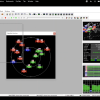SparkFun recently finished up a series of short videos called Funny You Should Ask that covers acronyms and electronics concepts in under 1 minute. Since producing a bunch of boards that offer EEPROM, such as the SparkFun Qwiic EEPROM Breakout we figured it would be smart to explain just what EEPROM is. But to explain EEPROM, you need to understand EPROM, PROM, and ROM. So we might as well explain all 4 within the series.
Dryw started us out with what is ROM. What even is ROM? It stands for Read-Only Memory and is a type of non-volatile memory that permanently stores data and instructions for a computer, even when the power is turned off. Unlike RAM, ROM cannot be easily modified or rewritten, making it ideal for storing firmware or software that doesn't need frequent updates. Dryw explains in this video.
Then we went on to explain PROM. It stands for Programmable Read-Only Memory. It's a type of ROM that is initially blank and can be programmed once by the user using a special device called a programmer. Once written, the data on PROM is permanent and cannot be altered or erased. Dryw explains further in this video.
Then came EPROM. What even is EPROM? It stands for Erasable Programmable Read-Only Memory. It is a type of memory that can be programmed, erased, and reprogrammed multiple times. It can be erased by exposing the chip to ultraviolet light, after which it can be reprogrammed with new data. Dryw explains in this video.
And finally EEPROM. It stands for Electrically Erasable Programmable Read-Only Memory. It is a type of non-volatile memory that can be electrically erased and reprogrammed, allowing for selective updates to specific sections of data. Unlike EPROM, which requires UV light for erasure, EEPROM can be erased and rewritten multiple times without removing it from the device. Dryw explains in this video.
Here's a table summarizing the differences between ROM, PROM, EPROM, and EEPROM:
| Type | Description | Programming Method | Erase Method | Use Case |
|---|---|---|---|---|
| ROM | Read-Only Memory; data is permanently written during manufacturing. | Programmed during manufacturing | Not erasable | Firmware for devices where data never changes |
| PROM | Programmable ROM; can be programmed once after manufacturing. | Programmed by user (one-time only) | Not erasable | Applications needing permanent data but with post-manufacturing setup |
| EPROM | Erasable Programmable ROM; data can be erased and reprogrammed multiple times. | Programmed using a special EPROM programmer | Erased by exposure to UV light | Systems where data might need updates, but not frequently |
| EEPROM | Electrically Erasable Programmable ROM; can be erased and reprogrammed many times using electrical signals. | Programmed using electrical signals | Erased electrically (selective erase) | Devices needing frequent data updates, such as BIOS settings and firmware updates |
Now if you are still trying to figure out what all of these acronyms mean, we have a variety of blog posts and tutorials that go way further into detail than these 1 minute videos. Make sure to stay updated on our blog to learn more about these concepts and more in the electronics world.
Follow SparkFun on YouTube and social media platforms for more of these Funny You Should Ask videos. What concepts and acronyms do you think we should cover?








